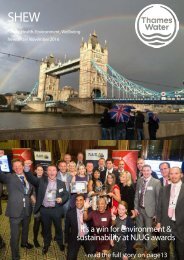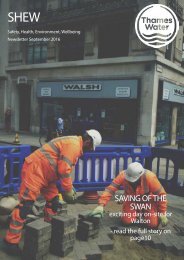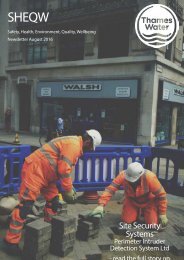SHEQWs Newsletter November
You also want an ePaper? Increase the reach of your titles
YUMPU automatically turns print PDFs into web optimized ePapers that Google loves.
In the spotlight<br />
Tunnel Inspections - Walthamstow<br />
Overview<br />
In early <strong>November</strong> the team mobilised in Walthamstow<br />
fishery’s to undertake various tunnel inspections.<br />
The first was tunnel was only a few hundred meters long<br />
and was in good order with next to no mussel or silt inside.<br />
Following on from this a compound was set up in the<br />
Lockwood compound opposite the main fisheries, to allow<br />
for works to the second tunnel , which spanned 6km to<br />
begin. Shortly after the spine tunnel was started which<br />
runs from the break pressure tank just south of the William<br />
Girling Reservoir to Coppermills Water Treatment Works.<br />
Preparing for the tunnel cleaning<br />
Once the permits were acquired by eight20 from Thames<br />
Water, the survey was undertaken. With all the lift plans,<br />
isolation procedure and RAMS in places.<br />
Firstly a floating pontoon was set up with a frame, block<br />
and tackle attached allowing them to pick up the isolation<br />
plates and float them into position, once they had been<br />
lifted into the water using a 25t city crane.<br />
The isolation plates consisted of three C section plates<br />
and a cover lid. Each C section is approx. 1mtr high and<br />
2.0mtrs long. These are all bolted together with gaskets<br />
between every section, along the head wall and then<br />
studded to the base. Once the isolation plates were in<br />
the water, specialist divers were bought in to survey the<br />
shafts. Each section was installed until completed and the<br />
process repeated at two locations shaft A & C.<br />
Once all the isolation plates were installed, the tunnel was<br />
isolated and the instruction was given to drain down the<br />
tunnel. To do this a permits to pump was raised and the<br />
pumping was monitored until the tunnel was empty.<br />
Tunnel Cleaning & Inspection<br />
Once the tunnel was drained, the survey phase of the<br />
works could begin. It was at this stage that the amount of<br />
mussels/ silt within the tunnel was apparent.<br />
The survey started at shaft A where the tunnel was almost<br />
completely full with only 300mm gap to crown. It was<br />
because of this that the survey was abandoned at shaft<br />
A and attempted at shaft C where debris depths of 8 to<br />
900mm were found and so the survey was deemed unsafe<br />
to continue until the waste had been removed.<br />
DISAB suction units were then employed to extract the<br />
mussels and silt waste. This involved connecting 6”hoses<br />
down the shaft and working from the main riding basket<br />
at the pit bottom to clear the way into the tunnel.<br />
Ventilation fans were also installed to purge the tunnel<br />
along with specialist ammonia gas detectors.<br />
Barhale continued to extract waste and clear the tunnel<br />
for a number of weeks by extending the hose into the<br />
tunnel. However due to the amount of build-up, trollies<br />
and bins were also used as a much faster way to move the<br />
material.<br />
Once the tunnel was completely cleaned it was then<br />
inspected by Thames Water and eight20.<br />
Page 8 | <strong>November</strong> 2016 SHEW <strong>Newsletter</strong><br />
SHEW <strong>Newsletter</strong><br />
<strong>November</strong> 2016 | Page 9
















